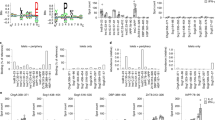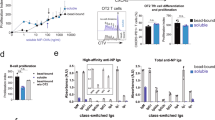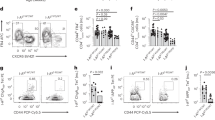Abstract
T LYMPHOCYTES reactive to pancreatic β-cells are thought to have a central role in the autoimmune process leading to type 1 (insulin-dependent) diabetes1–6, but the molecular targets of these T cells have not yet been defined. As identification of such antigens may enable measures to be developed to prevent the disease, we have characterized an antigen that is recognized by insulinoma membrane-reactive T-cell clones established from a newly diagnosed type-1 diabetes patient7. Subcellular fractionation studies using rat insulinoma indicate that the antigenic determinant recognized by one of these clones is an integral membrane component of the insulin secretory granule. After a 5,000-fold purification, we have defined the antigen as a monomer of relative molecular mass 38,000. As granular membrane proteins are transiently exposed on the cell surface during exocytosis, their accessibility to components of the immune system may be a function of the secretory activity of β-cells.
This is a preview of subscription content, access via your institution
Access options
Subscribe to this journal
Receive 51 print issues and online access
$199.00 per year
only $3.90 per issue
Buy this article
- Purchase on Springer Link
- Instant access to full article PDF
Prices may be subject to local taxes which are calculated during checkout
Similar content being viewed by others
References
Bottazzo, G. F. et al. New Engl. J. Med. 313, 353–360 (1985).
Stiller, C. R. et al. Science 223, 1362–1367 (1984).
Mandrup-Poulsen, T. et al. Lancet i, 599–602 (1989).
Sibley, R. K., Sutherland, D. E. R., Goetz, F. & Michael, A. F. Lab. Invest. 53, 132–144 (1985).
De Berardinis, P. et al. Lancet ii, 823–824 (1988).
Haskins, K., Portas, M., Bergman, B., Lafferty, K. & Bradley, B. Proc. natn. Acad. Sci. U.S.A. 86, 8000–8004 (1989).
Van Vliet, E., Roep, B. O., Meulenbroek, L., Bruining, G. J. & De Vries, R. R. P. Eur. J. Immun. 19, 213–216 (1989).
Guest, P. C., Pipeleers, D., Rossier, J., Rhodes, C. J. & Hutton, J. C. Biochem. J. 264, 503–508 (1989).
Hutton, J. C., Penn, E. J. & Peshavaria, M. Diabetologia 23, 365–373 (1982).
Hutton, J. C. Diabetologia 32, 271–281 (1989).
Day, I. N. M. Molec. cell. Probes 1, 275–295 (1987).
Sugiura, M. et al. Diab. Res. 3, 111–114 (1986).
Sugiura, M. et al. Diab. Res. 4, 63–66 (1987).
Bottazzo, G. F., Florin-Christensen, A. & Doniach, D. Lancet ii, 1279–1283 (1974).
Bruining, G. J., Molenaar, J. L. & Grobbee, D. E. Lancet i, 1100–1103 (1989).
Palmer, J. P. et al. Science 222, 1337–1339 (1983).
Baekkeskov, S. et al Nature 298, 167–169 (1982).
Powers, P. C., Rabizadeh, A., Akeson, R. & Eisenbarth, G. S. Endocrinology 114, 1338–1343 (1984).
Prud'homme, G. J., Fuks, A., Colle, E. & Guttman, R. D. Diabetes 33, 801–803 (1984).
Miller, B. J., Appel, M. C., O'Neil, J. J. & Wicker, L. S. J. Immun. 140, 52–58 (1988).
Charlton, B. & Mandel, T. E. Diabetes 37, 1108–1112 (1988).
Greiner, D. L. et al. J. exp. Med. 166, 461–475 (1987).
Dampe, O., Andersson, A., Bjork, E., Hallberg, A. & Karlsson, F. A. Diabetes 38, 1326–1328 (1989).
Gotfredson, C. F., Buschard, K. & Frandsen, E. K. Diabetologia 28, 933–935 (1985).
Acha-Orbea, H. et al. Cell 54, 263–273 (1988).
Janeway, C. A. Nature 341, 482–483 (1989).
Laemmli, U. K. Nature 227, 680–685 (1970).
Author information
Authors and Affiliations
Rights and permissions
About this article
Cite this article
Roep, B., Arden, S., de vries, R. et al. T-cell clones from a type-1 diabetes patient respond to insulin secretory granule proteins. Nature 345, 632–634 (1990). https://doi.org/10.1038/345632a0
Received:
Accepted:
Issue Date:
DOI: https://doi.org/10.1038/345632a0
This article is cited by
-
Type 1 diabetes mellitus as a disease of the β-cell (do not blame the immune system?)
Nature Reviews Endocrinology (2021)
-
Local immunomodulation with Fas ligand-engineered biomaterials achieves allogeneic islet graft acceptance
Nature Materials (2018)
-
Immunogenicity of human embryonic stem cell-derived beta cells
Diabetologia (2017)
-
Innate and adaptive immunity to human beta cell lines: implications for beta cell therapy
Diabetologia (2016)
-
Accumulation of autoreactive effector T cells and allo-specific regulatory T cells in the pancreas allograft of a type 1 diabetic recipient
Diabetologia (2009)
Comments
By submitting a comment you agree to abide by our Terms and Community Guidelines. If you find something abusive or that does not comply with our terms or guidelines please flag it as inappropriate.



